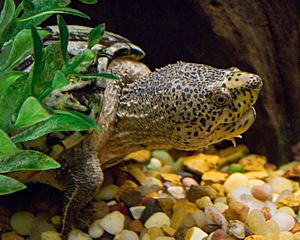Loggerhead musk turtle facts for kids
Quick facts for kids Loggerhead musk turtle |
|
|---|---|
 |
|
| Hatchling loggerhead musk turtle | |
| Scientific classification | |
| Genus: |
Sternotherus
|
| Species: |
minor
|
| Synonyms | |
|
|
The loggerhead musk turtle (Sternotherus minor) is a species of turtle in the family Kinosternidae. The species is native to the southern United States.
Contents
Geographic distribution
Within the southeastern United States, the loggerhead musk turtle can be found in Alabama, northern Florida, Georgia, extreme southeastern Kentucky, extreme eastern Louisiana, Mississippi, extreme western North Carolina, eastern Tennessee, and extreme southwestern Virginia.
Description and Differences
The loggerhead musk turtle gets its common name from its unusually large head, compared to the common musk turtle (Sternotherus odoratus). Adults can be 8–13 cm (3–5 inches) in straight carapace length. They are very similar to the Razorback Musk Turtle which is slightly larger. Adult loggerhead musk turtles have a flatter shaped carapace. Although the razorback musk turtles have a higher and more dome shaped carapace. Barbels are present on the chin only, not on the throat.
Habitat
Sternotherus minor lives in clean freshwater habitats such as springs, streams, and rivers.
Reproduction
S. minor is oviparous. Hatchlings have a straight carapace length of 2.2–2.8 cm (0.87–1.10 in). They have three prominent keels on the carapace, and they have a pinkish unmarked plastron.
- Agassiz L (1857). Contributions to the Natural History of the United States of America. Vol. I. Boston: Little, Brown, and Co. li + 452 pp. (Goniochelys minor, new species, p. 424).
- Behler JL, King FW (1979). The Audubon Society Field Guide to North American Reptiles and Amphibians. New York: Alfred A. Knopf. 743 pp. ISBN: 0-394-50824-6. (Sternotherus minor, p. 444 + Plates 311-312).
- McCoy CJ, Bianculli AV, Vogt RC (1978). "Sternotherus minor in the Pascagoula River system, Mississippi". Herpetological Review 9 (3): 109.
- Smith HM, Brodie ED Jr (1982). Reptiles of North America: A Guide to Field Identification. New York: Golden Press. 240 pp. ISBN: 0-307-13666-3. (Sternotherus minor, pp. 28–29).
- Smith HM, Glass BP (1947). "A new musk turtle from the southeastern United States". J. Washington Acad. Sci. 37 (1): 22-24. (Sternotherus peltifer, new species).
.
.
Images for kids
See also
 In Spanish: Sternotherus minor para niños
In Spanish: Sternotherus minor para niños



